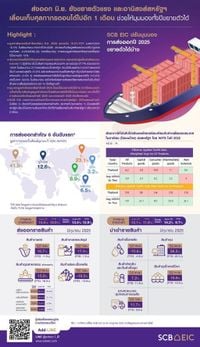Thailand's export sector has enjoyed a remarkable run in the first half of 2025, with growth sustained over 12 consecutive months, but signs are emerging that the momentum may slow as the year progresses. According to the Ministry of Commerce, exports in June reached $28.65 billion, marking a 15.5% year-on-year increase. This growth was driven primarily by accelerated imports from key trading partners, particularly the United States, as buyers rushed to stockpile goods ahead of anticipated tariff hikes.
The first half of 2025 saw Thai exports expand 15% overall, totaling $166.85 billion. Imports also rose, up 11.6% to $166.91 billion, with a notable surge in imports from China, which climbed 31.8% to $49.51 billion. The trade balance for June showed a surplus of $1.06 billion, a positive figure amid ongoing global economic uncertainties.
Director of the Office of Trade Policy and Strategy, Poonpong Nainapakorn, attributed the strong export numbers in June to a temporary reprieve in U.S. tariff enforcement. "The U.S. delayed retaliatory tariffs, prompting American importers to accelerate purchases of Thai goods to hedge against future price increases," he explained. This demand was especially evident in electronics and digital industry components, as well as agricultural products such as fresh and frozen fruits, tapioca, palm oil, sugar, processed chicken, and pet food.
Industrial exports also performed robustly, growing 19.3% in the first half of the year. Key contributors included computers and components, rubber products, machinery, electrical circuits, and jewelry (excluding gold). However, some sectors faced declines, notably automobiles and related parts, chemicals, and semiconductor components.
The U.S. market was a standout, with exports surging 41.9%, driven by the electronics sector, including computers and telecommunication equipment. China, the European Union, ASEAN countries, and Japan also posted healthy export growth, underscoring Thailand's diversified trade relationships.
However, the Ministry of Commerce cautions that export growth may decelerate starting July due to looming tariff measures and a strengthening Thai baht. Poonpong emphasized that the outcome of ongoing negotiations with the U.S. over retaliatory tariffs, set to take effect on August 1, will be pivotal. "If Thailand secures tariff rates comparable to regional competitors, around 18-20%, the impact on exports will be manageable. But higher rates could undermine Thailand's competitiveness," he warned.
Supporting this view, the Economic Intelligence Center of Siam Commercial Bank (SCB EIC) highlighted that the export surge in early 2025 was partly due to a 'frontloading' effect, where exporters rushed shipments ahead of the tariff deadline. SCB EIC noted that the U.S. President Donald Trump's decision to postpone reciprocal tariff collection by a month to September 1 provided a temporary boost to exports but warned that risks remain for the latter half of 2025 and into 2026.
SCB EIC's analysis reveals that only six countries, including the UK, China, Japan, Vietnam, Indonesia, and the Philippines, have successfully negotiated trade agreements with the U.S. to mitigate tariff impacts. These agreements often involve significant market openings to U.S. goods in exchange for reduced tariffs. For instance, Vietnam agreed to eliminate tariffs on U.S. products entirely, while Indonesia opened 99% of its market, excluding products conflicting with religious principles.
Thailand's negotiators have recently submitted a new proposal to the U.S. Trade Representative (USTR), increasing market access for U.S. products from 64% to approximately 90%. This move aims to reduce the retaliatory tariff rate from a potential 36% down to the 18-20% range, aligning with regional peers. However, this liberalization could have broad domestic implications, particularly for key agricultural sectors, potentially affecting producers and employment.
The opening of ASEAN markets to U.S. products, coupled with existing Chinese imports, creates a 'twin influx' challenge for Thailand. This dual pressure threatens to erode Thailand's export competitiveness within ASEAN, a critical market accounting for 23.3% of Thai exports in 2024. The agricultural and manufacturing sectors are particularly vulnerable as they face intensified competition from both U.S. and Chinese goods.
Moreover, any adverse effects on China's economy from ASEAN-U.S. transshipment agreements could provoke retaliatory tariffs from China, posing additional risks for Thai exports, given that China represents nearly 12% of Thailand's export market.
Thailand's domestic consumer market exhibits strong demand for U.S. products, ranking second highest in ASEAN despite higher tariffs designed to protect local industries. The country's Effective Applied Tariff Rate (EATR) on U.S. goods is the second highest in ASEAN, indicating a relatively protective stance. This protection is notably higher in categories such as agricultural products, where tariffs on U.S. vegetables and meats can reach up to 218%, far exceeding the ASEAN average.
Despite these challenges, the Thai government is proactively preparing to cushion the impact of these trade shifts. Measures include enhanced monitoring to prevent tariff circumvention on 49 key products, increased trade promotion efforts targeting new markets in the Middle East, South Asia, Latin America, and Europe, and accelerated free trade agreement negotiations with the EU, South Korea, and the UAE. Additionally, a 200 billion baht soft loan package has been established to support businesses affected by the U.S. tariffs.
In summary, while Thailand's export sector has demonstrated resilience and growth in the first half of 2025, the landscape is poised for significant change. The interplay of U.S. tariff policies, regional trade agreements, and currency fluctuations will heavily influence Thailand's trade trajectory. The coming months will be crucial as Thailand navigates these complex dynamics to sustain its export momentum and safeguard its economic interests.


